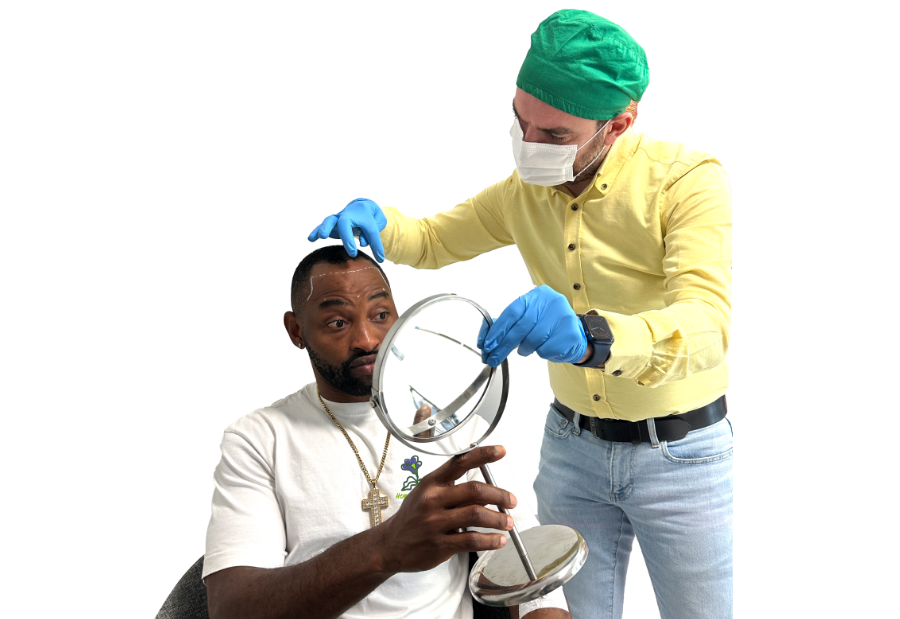Get 25% OFF Hair Transplant Packages This New Year — Book Today!
What Happens If You Don’t Tape Your Nose After Rhinoplasty?

Not taping your nose after rhinoplasty can lead to prolonged swelling, delayed healing, minor contour irregularities, and a less refined final result. Taping helps maintain the shape set by the surgeon and supports the soft tissues as they heal. Skipping this simple post-operative step may affect the outcome and delay the desired appearance of your new nose.
Rhinoplasty is one of the most delicate cosmetic surgeries if you’re still asking what is rhinoplasty surgery, it involves reshaping the bone and cartilage of the nose to improve function or appearance. Once the structure is modified, the skin must re-drape over the new framework. Taping plays a key role in guiding this process, especially in the first few weeks. If you’re wondering what happens if you don’t tape your nose after rhinoplasty, the truth is it can impact your recovery timeline and the aesthetic finish.
How to Tape Nose After Rhinoplasty the Right Way?
Taping should only begin once your doctor removes the external nasal splint, typically 6–7 days post-surgery. Using paper tape or medical-grade skin tape, patients are instructed on how to tape nose after rhinoplasty by gently applying strips in a U-shape across the bridge, extending under the tip. The goal is to compress the nasal tissue lightly to reduce swelling and help contour the nose.
Incorrect taping can cause pressure sores, skin peeling, or even undesired dents if placed too tight. So, always follow your surgeon’s taping technique and product recommendations.
How Tight Should I Tape My Nose After Rhinoplasty?
When asking how tight should I tape my nose after rhinoplasty, the answer is: firm but gentle. The tape should support the nose without causing any discomfort or restricting blood circulation. If you notice deep imprints, numbness, or excessive pressure, it’s likely too tight.
Overly tight taping can damage the soft tissue, while loose taping won’t serve its purpose. A properly taped nose feels supported and snug, but never painful.
Taping Nose 6 Months After Rhinoplasty: Still Necessary?
In most cases, taping nose 6 months after rhinoplasty is unnecessary. By this time, your nasal tissues and cartilage have settled into their permanent shape. However, in certain individuals with thicker skin or persistent swelling (especially in the nasal tip), your surgeon might recommend occasional taping even after six months.
For patients with slow-resolving edema or skin laxity, extended taping may still offer subtle improvements. Always consult your surgeon before continuing tape use this late into recovery.
How Long Should I Tape My Nose After Rhinoplasty?
How long should I tape my nose after rhinoplasty generally depends on skin type, swelling, and the specific surgical technique. Typically, surgeons recommend taping the nose every night for at least 4 to 8 weeks. In cases involving thicker skin or revision rhinoplasty, taping may be advised for 3–6 months.
Nighttime taping is particularly helpful, as it combats the natural swelling that can occur from lying down. For best results, maintain consistency with your taping routine.
How Often Should I Tape My Nose After Rhinoplasty?
Most surgeons suggest how often should I tape my nose after rhinoplasty is once per day, ideally overnight. The duration may vary, but a regular nightly taping session for 8 to 12 hours is standard for reducing swelling and helping the skin adjust to the new shape.
You may start with full-day taping during the first week after splint removal, and gradually reduce to nightly sessions as healing progresses. Missing occasional nights won’t affect the results drastically, but frequent neglect might prolong swelling.
Do You Have to Tape Your Nose After Rhinoplasty When Flying?
Yes, you do have to tape your nose after rhinoplasty when flying, especially within the first month post-op. Air travel exposes the body to altitude-related pressure changes, which can worsen post-surgical swelling.
Taping nose after rhinoplasty on plane journeys helps reduce edema and prevents fluid retention around the nasal tissues. Make sure to carry extra hypoallergenic tape and tape your nose before boarding. Avoid long flights in the initial two weeks unless your surgeon approves.
Is It Dangerous Not to Tape Your Nose at All?
While skipping a few taping sessions isn’t hazardous, ignoring it completely can lead to prolonged puffiness, minor asymmetries, or a broader nasal appearance than intended. The skin might not settle snugly over the cartilage, especially in thick-skinned patients.
By not taping, you risk a slightly less refined outcome, especially if you’re prone to swelling or had major structural reshaping done. It’s not dangerous, but it’s highly recommended for optimal results.
Taping the Nose During Nighttime
Taping the nose at night after rhinoplasty is highly recommended by most surgeons because swelling tends to accumulate when lying down. Overnight taping helps compress the nasal tissues and maintain the refined contour of the nose while you sleep. It also supports the healing cartilage and skin as they adapt to the new structure.
Even if you’re taping only once per day, doing it at night is most effective. The consistent pressure applied by the tape helps limit fluid retention and improves the long-term aesthetic outcome. For patients with thick skin or stubborn swelling, nighttime taping may be advised for several weeks or even months.
Does Nose Taping Make the Nose Smaller?
Nose taping does not permanently reduce the size of the nose, but it can help make it appear more defined by controlling swelling. The tape compresses soft tissues and skin, helping them mold to the newly shaped nasal framework. This effect is especially noticeable in patients with bulbous tips or thick skin.
So while taping doesn’t shrink bone or cartilage, it assists in faster contour refinement and a more sculpted look during recovery. In this way, taping may make the nose appear smaller and sharper as swelling subsides.
What Are the Potential Effects of Long-term Use of Nose Tapes?
Extended use of nose taping is generally safe when done properly, but overdoing it or using harsh tape can lead to:
- Skin irritation or redness
- Breakouts or allergic reactions
- Skin thinning or pigmentation (in sensitive individuals)
- Minor dents if tape is applied too tightly or unevenly
It’s important to use hypoallergenic, medical-grade tape and follow your surgeon’s advice on how long to continue taping. For most patients, long-term taping beyond 3–4 months is unnecessary unless there’s significant swelling or thick skin.
Comparing Tape and Splints After Rhinoplasty
Both tape and splints serve different purposes during rhinoplasty recovery:
- Nasal splints are rigid and used immediately after surgery to hold the nasal bones in place. They provide structural support and prevent injury during the critical early healing period.
- Taping, on the other hand, is used after splint removal to control swelling, help skin shrink-wrap to the new shape, and provide gentle support during tissue remodeling.
Splints are typically worn for 5–7 days post-surgery, while taping may continue for several weeks or months depending on the patient’s healing needs. While splints are essential early on, taping is more about enhancing results and reducing residual puffiness.
Will Not Taping Alter the Shape of My Nose?
Although it won’t drastically deform the nose, not taping can allow residual swelling to linger and potentially hide your final result longer. The nasal tip and bridge may appear rounder or puffier than they would with proper taping.
Also, uneven healing or tissue shifting could result in slight asymmetry. Taping gives gentle guidance to the healing skin and cartilage, minimizing these risks.
Why Is Taping Such an Important Part of Rhinoplasty Recovery?
Taping is not just cosmetic it’s a strategic recovery tool. It provides external support, reduces dead space where fluid can collect, and speeds up skin contraction. Whether you’re dealing with post-op swelling or skin thickness, taping ensures your new nasal framework remains as defined as your surgeon sculpted it.
It’s a non-invasive, low-cost method that significantly enhances your recovery experience and outcome.
Conclusion
Taping your nose after rhinoplasty is a simple yet powerful recovery practice. It plays a critical role in shaping your final results, especially in the first few weeks. Now you know exactly what happens if you don’t tape your nose after rhinoplasty expect longer swelling, potential asymmetry, and delayed refinement.
Looking for expert rhinoplasty care and post-op guidance? Contact Grace Touch Clinic for trusted rhinoplasty surgery treatment in Turkey.
For best outcomes, follow your surgeon’s taping schedule, technique, and timeline. If you’re planning travel or feeling discomfort, always consult your clinic for safe adjustments.

